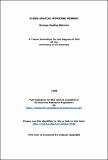Files in this item
Visuo-spatial working memory
Item metadata
| dc.contributor.advisor | Quinn, J. G. | |
| dc.contributor.author | Ralston, George Eastop | |
| dc.coverage.spatial | 264 p. | en_US |
| dc.date.accessioned | 2016-10-03T10:55:41Z | |
| dc.date.available | 2016-10-03T10:55:41Z | |
| dc.date.issued | 1988 | |
| dc.identifier | uk.bl.ethos.234100 | |
| dc.identifier | uk.bl.ethos.234100 | |
| dc.identifier.uri | https://hdl.handle.net/10023/9595 | |
| dc.description.abstract | This study set out to investigate the visuo-spatial component of Baddeley and Hitch's (1974) Working Memory framework. The development of our understanding of this component has been less dramatic than that of its verbal counterpart, the Articulatory Loop. The primary reason for this can be said to be the lack of techniques for investigation (Logie, 1986). This thesis presents one attempt to try to explore the nature of this code and to reveal possible new techniques of investigation. The following are three possible areas of investigation : 1. Is the system spatially or visually based? 2. Does movement have a role in the system? 3. How is information stored? The latter two issues are investigated here. Experiments 1-4 set out to explore the possibility that movement may be involved in the code. These experiments supported the idea that movement has a role to play in spatial coding and more specifically demonstrated that arm movements which are not compatible with the presentation of spatial material can cause disruption. In addition it was shown that when movement identical to that involved in presentation is encouraged at recall subjects show marked improvement in performance. Together these results very strongly suggest that movement should be given prominent reference in the definition of spatial coding and in the description of the visuo-spatial slave system. Another development that came out of these experiments relates to the lack of investigative techniques in the field of visuo-spatial short term memory. The fact that movement has been shown to be important suggests that techniques employed to investigate kinaesthetic memory will aid us in exploring visuo-spatial coding. The second issue in this thesis explored further the nature of the internal code. Research into the nature of coding in visuo-spatial memory had previously argued for the presence of a sequential component. Experiments 1-4 in this thesis had shown that movement had an important role to play in coding. The fact that movement by its very nature would appear to be sequential suggested that there was a strong sequential element in coding within visuo-spatial memory. However, concern was expressed that the materials and presentation format used may have led to sequential coding. This was first explored in experiments 5-8. The results supported the view that the material and presentation format used had led to sequential coding. This was further explored by Experiments 9 and 10 which illustrated that while it may be important under certain conditions, sequentiality is not always a dominant element in coding within the Visuo-Spatial Sketch Pad. This thesis has explored two of the central issues currently interesting theorists of Working Memory and has put forward suggestions for techniques which may in the future help us to advance our knowledge of the visuo-spatial component of the Working Memory framework. | en_US |
| dc.language.iso | en | en_US |
| dc.publisher | University of St Andrews | |
| dc.subject.lcc | BF378.V5R2 | |
| dc.subject.lcsh | Short-term memory | en_US |
| dc.subject.lcsh | Visual perception | en_US |
| dc.title | Visuo-spatial working memory | en_US |
| dc.type | Thesis | en_US |
| dc.contributor.sponsor | Science and Engineering Research Council (SERC) | en_US |
| dc.type.qualificationlevel | Doctoral | en_US |
| dc.type.qualificationname | PhD Doctor of Philosophy | en_US |
| dc.publisher.institution | The University of St Andrews | en_US |
This item appears in the following Collection(s)
Items in the St Andrews Research Repository are protected by copyright, with all rights reserved, unless otherwise indicated.

